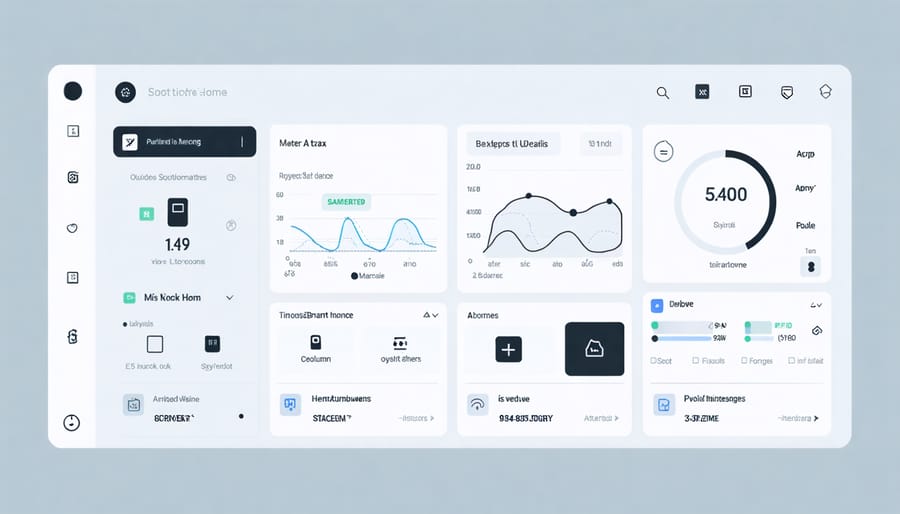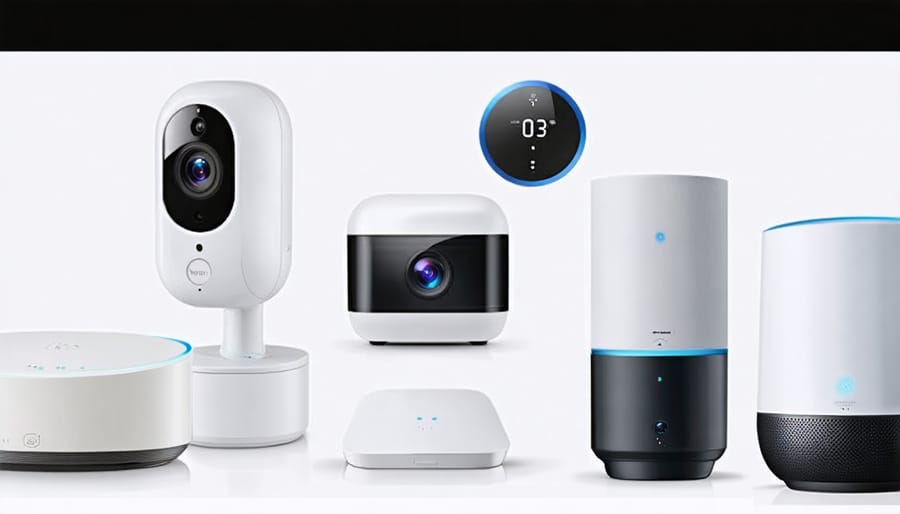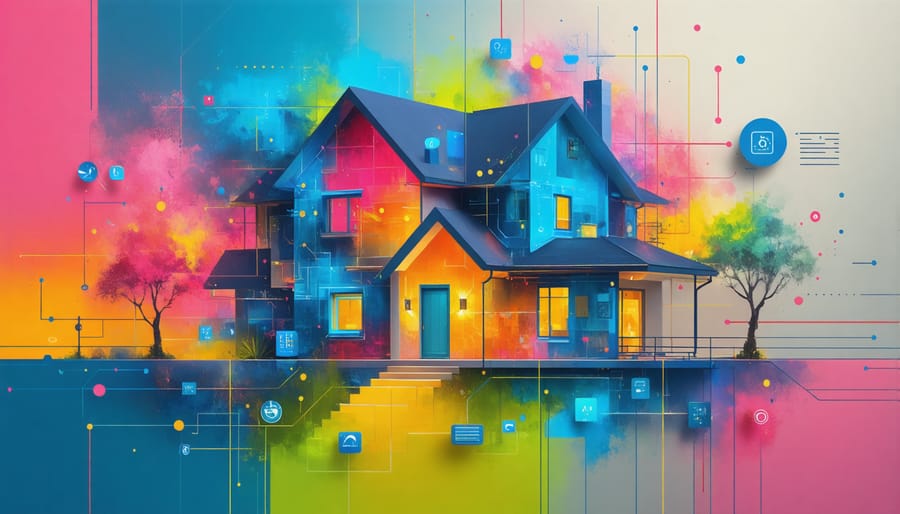Transform your home’s security and efficiency in one seamless system by integrating utility controls with smart security features. Modern smart home energy management systems now combine motion sensors that trigger both security alerts and automated lighting, while smart thermostats adjust temperatures based on occupancy patterns, creating a dual-purpose safety and savings solution. Advanced utility monitoring detects unusual water flow or power usage patterns, instantly alerting homeowners to potential security breaches or equipment malfunctions through their smartphones. This integration not only strengthens home security but typically reduces utility bills by 15-30% through automated efficiency controls and real-time usage monitoring. Whether you’re a tech enthusiast or just starting your smart home journey, these intelligent systems offer peace of mind while maximizing your home’s energy efficiency.

The Power of Connected Security and Utility Systems
Real-Time Monitoring and Alerts
Your smart home’s utility systems work hand-in-hand with integrated security features to keep your home safe by monitoring patterns in real-time. Think of it as having a vigilant guardian that notices when something’s not quite right with your utilities.
For instance, if your water usage suddenly spikes during vacation, the system can immediately alert you to potential pipe leaks or break-ins. Similarly, unusual electricity patterns during off-hours might indicate unauthorized access or forgotten appliances left running.
These smart systems learn your typical usage patterns over time. When they detect deviations – like power being used at odd hours or gas flowing when no one’s home – you’ll receive instant notifications on your smartphone. You can set custom thresholds and rules, so you’re only alerted about truly concerning situations.
What’s particularly helpful is that these alerts don’t just warn you about potential security threats; they also help prevent costly utility waste and damage to your home. You can even give trusted neighbors or family members access to these alerts as an extra layer of protection when you’re away.
Automated Response Features
Your smart home’s automated response features act as a vigilant guardian, ready to react instantly to potential security threats through intelligent utility control. When suspicious activity is detected, the system springs into action with a coordinated response that leverages your home’s utilities for enhanced protection.
For example, if motion sensors detect unexpected movement outside your home at night, the system can automatically flood the area with light, deterring potential intruders. Inside, lights can flash throughout the house to alert occupants and create the impression of an active household. The system can even cut power to vulnerable entry points, like garage doors or electronic locks, preventing unauthorized access attempts.
During emergencies like gas leaks or water main breaks, automated responses kick in immediately. The system shuts off the appropriate utility supply, preventing further damage and potential safety hazards. It simultaneously alerts you through your smartphone and can contact emergency services if needed.
These automated responses are customizable to your specific needs and can be fine-tuned based on different scenarios, time of day, or occupancy status, providing peace of mind whether you’re home or away.

Essential Components of a Utility-Integrated Security System
Smart Lighting Control
Modern smart lighting control systems offer far more than just convenience – they’re a powerful tool for enhancing your home’s security. By programming your lights to mimic your daily routines, you can create the impression that someone’s always home, even when you’re away.
Set up motion-activated lights around entry points to deter potential intruders and illuminate dark corners automatically. Many systems allow you to create realistic “lived-in” scenarios, where lights turn on and off in different rooms throughout the evening, just as they would if you were home.
Control your lights remotely through your smartphone, allowing you to adjust lighting on the fly if plans change. Most systems also integrate with other security features, such as cameras and alarm systems, creating a comprehensive security network. For instance, if your security camera detects movement, your lights can automatically illuminate the area.
Schedule your outdoor lights to activate at sunset and deactivate at sunrise, ensuring your property remains well-lit during vulnerable nighttime hours. This automatic adjustment not only enhances security but also helps save on energy costs by preventing lights from running unnecessarily during daylight hours.
Climate Control Integration
Smart HVAC systems do more than just keep your home comfortable – they’re a crucial component of your home’s security infrastructure. By monitoring temperature patterns and occupancy, these systems can detect unusual activities that might indicate a break-in. For instance, if your smart thermostat notices movement during times when your home is typically empty, it can trigger alerts and integrate with your security system.
Many modern climate control systems also include freeze protection, which prevents pipe damage during winter by maintaining minimum temperatures even when you’re away. Some systems can detect sudden temperature spikes that might indicate a fire, providing early warning before traditional smoke detectors activate.
You can enhance security further by setting up “occupied” scenes that automatically adjust temperatures and run fans intermittently when you’re on vacation, creating the impression that someone’s home. Plus, with remote monitoring capabilities, you’ll receive instant notifications about any unusual temperature fluctuations or system malfunctions that could compromise your home’s safety.
Water Leak Detection
Water leak detection systems are becoming an essential component of smart utility management, offering both protection against costly water damage and an additional layer of home security. These intelligent systems use strategically placed sensors to monitor water flow and detect unusual patterns that might indicate a leak or burst pipe.
When installed near water-prone areas like sinks, toilets, and appliances, these sensors can immediately alert you through your smartphone if they detect moisture. More advanced systems can even automatically shut off your home’s main water supply when they identify a potential problem, preventing extensive damage before it occurs.
Beyond preventing water damage, these systems can also serve as intrusion detection tools. By monitoring water usage patterns, they can alert you to unexpected water use when you’re away, potentially indicating unauthorized access to your home. This dual functionality makes water leak detection a smart investment for both utility management and home security.
For maximum effectiveness, consider integrating your water monitoring system with other smart home security features to create a comprehensive protection network.
Setting Up Your Integrated System
Choosing Compatible Devices
When building your smart home ecosystem, compatibility is key to ensuring all your devices work harmoniously together. Start by choosing a primary smart home platform like Google Home, Amazon Alexa, or Apple HomeKit. This decision will guide your future device purchases and make integration much smoother.
Look for devices that explicitly state their compatibility with your chosen platform. Many modern smart devices support multiple platforms, giving you more flexibility. Pay attention to communication protocols such as Wi-Fi, Zigbee, or Z-Wave when selecting devices. Wi-Fi devices are generally easier to set up but may strain your network, while Zigbee and Z-Wave devices create their own mesh networks and often offer better reliability.
Consider getting a smart hub if you plan to use devices from different manufacturers. Hubs like Samsung SmartThings can bridge various protocols and help different devices communicate effectively. Before purchasing any device, check its power requirements and whether it needs a separate bridge or controller to function.
For utility-focused devices like smart thermostats, water leak detectors, and energy monitors, ensure they can share data with your other security and automation systems. This integration allows for more comprehensive home monitoring and automated responses to potential issues.
Integration Best Practices
Getting the most out of your utility smart home system starts with thoughtful planning and strategic setup. Begin by creating a centralized hub that can communicate with all your devices – this foundation will make future expansions much smoother. When connecting multiple systems, ensure your Wi-Fi network is robust and secured with a strong password and encryption.
Consider creating automated routines that work together seamlessly. For example, program your thermostat to adjust when security sensors detect no movement, or set up water leak detectors to automatically shut off your main water supply when issues are detected. These integrated actions can prevent disasters and save money.
Keep your devices updated with the latest firmware to maintain security and compatibility. Group related devices by room or function in your smart home app for easier management. Back up your automation settings regularly to avoid losing your carefully crafted routines.
For optimal performance, position sensors and devices strategically – away from interference sources and within reliable range of your hub. Start with essential integrations and gradually add more as you become comfortable with the system. Remember to document your setup configurations and keep a list of connected devices for future reference.
Always test your automations thoroughly before relying on them, especially those involving critical utilities like heating or water systems.

Maximizing Security Through Smart Routines
Vacation Mode Settings
Going on vacation shouldn’t mean worrying about your home’s utilities. With smart home technology, you can set up automated routines that mimic your presence while maximizing energy efficiency during your absence. Start by creating a vacation schedule that adjusts your thermostat to energy-saving temperatures when you’re away, while ensuring your home stays protected from extreme conditions.
Program your smart lights to turn on and off at random intervals throughout the day, creating the impression that someone’s home. Many systems allow you to set different schedules for various rooms, making the simulation more realistic. You can also automate your smart blinds to open and close at specific times, further enhancing the lived-in appearance.
For added peace of mind, set up water leak detection alerts and automatic water shut-off in case of emergencies. Configure your security cameras and doorbell to send real-time notifications to your phone, and ensure your smart irrigation system adjusts watering schedules based on weather forecasts to prevent waste.
Remember to test your vacation mode settings before departing, and consider creating multiple seasonal profiles to account for different weather conditions throughout the year.
Daily Security Schedules
Setting up daily security schedules for your smart home creates a robust defense system that works quietly in the background. Start by programming your lights to follow your typical daily patterns, turning on and off at specific times to create the impression of occupancy, even when you’re away.
Create morning routines that automatically disarm your security system, turn on essential utilities, and adjust your thermostat as you wake up. Schedule your smart locks to automatically secure all doors at bedtime and check that your garage door is closed.
During the day, set your security cameras to increase sensitivity during typically vacant hours and reduce false alerts when family members are expected home. Program your smart thermostat to adjust temperatures based on occupancy patterns, saving energy while maintaining comfort.
Evening sequences should include exterior light activation at sunset, systematic interior lighting changes, and a final security check of all entry points. Consider setting up randomized light patterns during vacations to enhance the lived-in appearance of your home.
Remember to review and adjust these schedules seasonally as daylight hours change and your family’s routines evolve.
Privacy and Data Security Considerations
As we embrace the convenience of smart home utilities, it’s crucial to understand and address the privacy implications of these connected systems. Your utility smart home collects significant data about your daily routines, energy usage patterns, and personal habits. While this information helps optimize your home’s efficiency, it also requires careful protection.
To protect your smart home privacy, start by regularly updating all device passwords and enabling two-factor authentication whenever possible. Create a separate Wi-Fi network exclusively for your smart devices, keeping them isolated from your primary network where you handle sensitive information.
Pay attention to the privacy policies of your utility smart home devices and their accompanying apps. Look for devices that offer local data processing rather than cloud-based solutions when possible, and ensure your smart meter data is encrypted. Consider using a VPN to add an extra layer of security to your home network.
Regular security audits are essential. Review which devices have access to your network, what permissions they have, and what data they’re collecting. If you’re not actively using a smart feature, disable it until needed. Remember to check for and install firmware updates promptly, as these often include important security patches.
When integrating new devices, research the manufacturer’s track record with data security and customer privacy. Choose products from reputable companies that are transparent about their data collection practices and provide clear opt-out options for data sharing. By taking these precautions, you can enjoy the benefits of a smart home while maintaining your privacy and security.
As we’ve explored throughout this article, transforming your home into a utility smart home isn’t just about embracing the latest technology – it’s about creating a more secure, efficient, and comfortable living space that works for you. By integrating smart utility systems with your home security features, you’re not only enhancing your family’s safety but also making significant strides in energy conservation and cost savings.
The beauty of utility smart home solutions lies in their flexibility and scalability. Whether you start small with smart thermostats and water leak detectors or dive into a comprehensive home automation system, each step brings you closer to a more connected and secure living environment. The initial investment in these technologies typically pays for itself through reduced utility bills and prevented damage from potential emergencies.
Remember, implementing smart utility features doesn’t have to be overwhelming. Start with the areas that matter most to you, whether that’s energy management, water conservation, or enhanced security. As your comfort level grows, you can gradually expand your system to include more features and capabilities.
The future of home management is here, and it’s smarter than ever. By taking action today to implement utility smart home solutions, you’re not just making your home more efficient – you’re investing in peace of mind and preparing your living space for the technologies of tomorrow. Take that first step toward a smarter, safer home, and join the growing community of homeowners who are revolutionizing the way we live.
